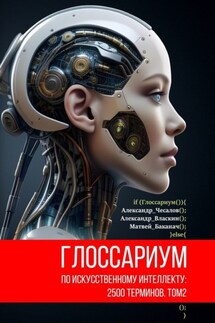Глоссариум по искусственному интеллекту: 2500 терминов. Том 2 - страница 11
Artificial intelligence technologies – technologies based on the use of artificial intelligence, including computer vision, natural language processing, speech recognition and synthesis, intelligent decision support and advanced methods of artificial intelligence89.
Artificial life (Alife, A-Life) is a field of study wherein researchers examine systems related to natural life, its processes, and its evolution, through the use of simulations with computer models, robotics, and biochemistry. The discipline was named by Christopher Langton, an American theoretical biologist, in 1986. In 1987 Langton organized the first conference on the field, in Los Alamos, New Mexico. There are three main kinds of alife, named for their approaches: soft, from software; hard, from hardware; and wet, from biochemistry. Artificial life researchers study traditional biology by trying to recreate aspects of biological phenomena90.
Artificial Narrow Intelligence (ANI), also known as weak or applied intelligence, represents most of the current artificial intelligent systems which usually focus on a specific task. Narrow AIs are mostly much better than humans at the task they were made for: for example, look at face recognition, chess computers, calculus, and translation. The definition of artificial narrow intelligence is in contrast to that of strong AI or artificial general intelligence, which aims at providing a system with consciousness or the ability to solve any problems. Virtual assistants and AlphaGo are examples of artificial narrow intelligence systems91.
Artificial Neural Network (ANN) is a computational model in machine learning, which is inspired by the biological structures and functions of the mammalian brain. Such a model consists of multiple units called artificial neurons which build connections between each other to pass information. The advantage of such a model is that it progressively «learns» the tasks from the given data without specific programing for a single task92.
Artificial neuron is a mathematical function conceived as a model of biological neurons, a neural network. The difference between an artificial neuron and a biological neuron is shown in the figure. Artificial neurons are the elementary units of an artificial neural network. An artificial neuron receives one or more inputs (representing excitatory postsynaptic potentials and inhibitory postsynaptic potentials on nerve dendrites) and sums them to produce an output signal (or activation, representing the action potential of the neuron that is transmitted down its axon). Typically, each input is weighted separately, and the sum is passed through a non-linear function known as an activation function or transfer function. Transfer functions are usually sigmoid, but they can also take the form of other non-linear functions, piecewise linear functions, or step functions. They are also often monotonically increasing, continuous, differentiable, and bounded93,94.
Artificial Superintelligence (ASI) is a term referring to the time when the capability of computers will surpass humans. «Artificial intelligence,» which has been much used since the 1970s, refers to the ability of computers to mimic human thought. Artificial superintelligence goes a step beyond and posits a world in which a computer’s cognitive ability is superior to a human’s









